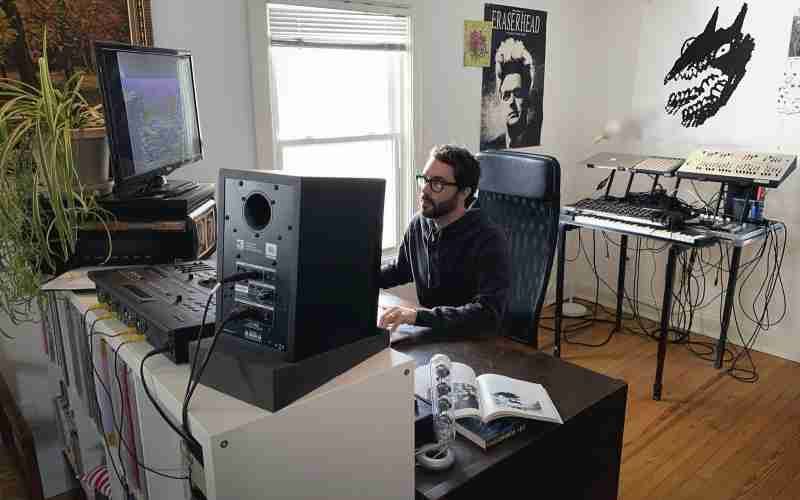Who can forget The Beatles’ crosswalk, the Velvet Underground’s banana, the Rolling Stones’ zipper, Judas Priest’s razor blade, Pink Floyd’s prism, Nirvana’s baby, and Blin k-182’s rubber glove? Album cover art has slipped the surly bonds of paper sleeves and become as culturally significant as the music it promotes.
Nate Utesch, a musician and graphic designer based in Fort Wayne, is in the business of designing album cover art and other eye-catching promotional graphics for bands, some of them household names.
Utesch has worked with Smashing Pumpkins, Weezer, Korn, Phoebe Bridgers, Conor Oberst, and comedian/musician Tim Heidecker, among many others.
Directing Art and Remastering Music
It all started in 2014 when Utesch left the local design firm One Lucky Guitar to be the art director for the Secretly Group, based in Bloomington, Indiana.
“At that point, I came on as the entire art department,” he said in a phone interview with Whatzup. “I was the art director for all three labels (Secretly Canadian, Jagjaguwar, and Dead Oceans). Now the art department is four people strong with two art directors. So I am responsible for half of the workload of all the three labels at any given time.”
Other interesting work has meandered into Utesch’s life in casual and random fashion.
A few years after Utesch started working for the Secretly Group, his band, Metavari, was signed to a label group based in Seattle called Light in the Attic. Light in the Attic reissues obscure rock, jazz, and funk releases through its Tidal Wave label. Utesch was called upon to restore album cover art and also to remaster music.
“It’s all sorts of crazy stuff, like horror movie soundtracks that have never been released on vinyl,” he said. “I just finished a Chet Baker record that hadn’t been re-released in forever.”
Utesch has worked on 100 albums for Tidal Wave. And he has worked on 275 releases to date for Secretly Group.
Cover Art, Background Story
His highest profile work, however, has happened with an Ohio company called Tension Division.
Through Tension Division, Utesch helped design cover art for The Smashing Pumpkins’ Cyr and Shiny and Oh So Bright, Vol. 1, Korn’s The Nothing, and Weezer’s self-titled release known colloquially as The Black Album.
The art deco images of a ghostly figure that grace the two aforementioned Smashing Pumpkins releases were created by Utesch for tour posters. And they were inspired by a Fort Wayne Ballet performance.
“It was the first thing I had ever seen the Fort Wayne Ballet do,” he said. “I had taken pictures and was using the male ballerinas as my references for sketches — these crazy, contorted forms.”
Smashing Pumpkins’ lead singer Billy Corgan wanted Utesch to make use of the same ghostly figure on subsequent projects. And he wanted the images to advance a narrative.
“Billy’s idea (for Shiny and Oh So Bright, Vol. 1) was like, ‘OK, that figure you drew for the poster? I want that figure to also be represented on this cover. It’s the same character in my mind. Help me tell that story. Why is he on this cover? What’s he doing?’”
Utesch and Corgan ended up composing a backstory for the character that explained his continued appearance on the covers of Shiny and Oh So Bright, Vol. 1 and Cyr.
“No one else may hear (the story), but it was a cool way to have a through-line for us to keep us honest,” he said. “That doesn’t happen a lot and that’s kind of the dream when you get to go that far with it and tell those kinds of stories. Not many artists like to go that far and get that romantic with it. But Billy just absolutely does. He really ate it up and added to it. It was so much fun.”
Smashing Pumpkins releases were some of the first albums Utesch owned, so it is understandable that he had a hard time hiding his giddiness while working with Corgan.
“It was crazy, crazy being on those early phone calls with Billy and texting my wife the whole time,” he says. “Telling her the crazy things he was saying but also trying to pay attention.”
Rejection and Rejoicing
Being an art director and graphic artist for musicians and record labels isn’t always glamourous. It often happens that a band rejects Utesch’s ideas or changes them so much that he is far less enthusiastic about claiming them as his own.
Rejection is often painful for Utesch.
“I have had bands who were not fun to work with,” he said. “Bands that have thrown stuff out after I have put 30 or 40 hours into a project. People have thrown stuff out and hired someone else. It’s always a bummer. It’s never any less painful for sure.”
Utesch does something seemingly unusual among graphic designers: He posts outtakes and rejected concepts to his website and to his social media pages.
“I have people in the industry say, ‘What’s your game? You are posting work that was thrown out.’ I often have something that was thrown in the trash that I am really proud of. As an active artist, it just makes sense to show the world the things that got pitched. Why not?”
Utesch said his Secretly Group rejects have inspired bands working with Tension Division —one musician’s trash thereby becoming another musician’s treasure.
Utesch’s kid-in-a-candy-store enthusiasm for his work extends to the record store. It thrills him to see his work in a record bin.
“I have had this conversation with people who work at peer labels and it’s funny how many people say they don’t care about that,” he said. “I think it’s an incredible thing. An LP is this artifact in the world. And now I am creating these artifacts that someone will find 40 years from now.
“My name is on all this junk I made and I think it’s awesome,” Utesch said. “There aren’t many careers where you’re spitting out artifacts into the earth like that.”



